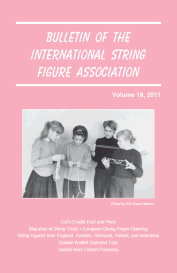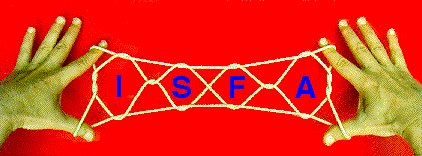Volume 18 (2011) - Table des Matières
Edité par - Mark A. Sherman, Pasadena, California
Rédacteurs Associés - Joseph D'Antoni, Queens, New York; Myriam Namolaru, Haifa, Israel;
Belinda Holbrook, Davenport, Iowa; Stephan Claassen, Best, Netherlands.
Comité de Rédaction - Hiroshi Noguchi, Tokyo, Japan; Philip Noble, Inverness, Ecosse
Le Bulletin de l'Association Internationale du Jeu de Ficelle (BISFA) est une publication savante
présentant des documents originaux qui fait progresser notre compréhension et renforce
notre plaisir des jeux de ficelle. BISFA est publié annuellement, en septembre, par ISFA Press
(Pasadena, Californie). BISFA remplace le Bulletin de l'Association des Jeux de Ficelle,
(Toky Nippon Ayatori Kyokai), qui a été publiée en 19 volumes (1978-1993).
Les traductions proposées ne comprennent pas les illustrations et photos du texte original.
J'ai traduit ces textes pour vous donner un aperçu de la qualité et de la richesse de
ces publications.

Research Reports
- Devonshire String Figures from the 1890s by Martin and Veronika Probert, Devonshire, UK (pages 1-12) - In Caroline Furness Jayne’s 1906 String Figures we learn of seven figures (apart from Cat's Cradle) collected from Great Britain. The eight figures in the present collection, with one exception, are different from those in Jayne's compilation, and appear to pre-date the publication of her book. A surprising feature of this collection is the appearance of some remarkable and hitherto unknown figures. These figures, coupled with those from other collectors, suggest that at some time Europe may have been a flourishing centre of string figure creativity.
- Le Berceau Européen Doigts-PLongeant par Martin Probert, Devonshire, UK (pages 13-30) - Trois jeux de ficelle européens, tous construits avec le meme berceau , révèle un motif saisissant avec les doigts plongés au centre des ficelles. Une analyse du berceau est réalisée, et onze figures 'doigts-plongeants' supplémentaires, inventées par l' auteur, ont été crées à partir de ce berceau européen 'doigts-plongeants'. (presque entièrement traduit)
- Cat's Cradle East and West by Martin Probert, Devonshire, UK (pages 31-39) - Part I takes a fresh look at the theory of an east-to-west migration of the twoperson Cat's Cradle game, and finds the basis of the theory untenable. Part II identifies string figures with the potential to evolve into the two-person game, and notes the existence or absence of these 'ancestral figures' in the surviving repertoires of East and West: the existence of such a figure indicates a possible origin and centre of migration.
- The Migration of String Tricks by Martin Probert, Devonshire, UK (pages 40-45) - Part I examines the theory that the string tricks of ethnographical collections were carried round the world by sailors, and discovers, in the sources where evidence might have been most expected, a significant lack of evidence. Part II offers an alternative theory to account for the wide distribution of these tricks.
- Swedish String Figures II: A 1970 Research in Uppsala by Stephan Claassen, Best, the Netherlands (pages 46-135) - In December 1970 Bo Almqvist and his students carried out a research project on string figures among children of two primary schools in Uppsala, Sweden. The resulting information on string figures, names and context, was stored away in the archives of Institutet för språk och folkminnen in Uppsala and never used. Here it is arranged and described for the first time. No construction methods for the figures were recorded, but it has been possible to reconstruct many of them. Additional material on string figures found in the Uppsala archives is described in appendices.
- Danish String Figures: A 1965-66 Film Transcription by Philip D. Noble, Inverness, Scotland (pages 136-195) - In Denmark string games are called "Snorelege". During the winter of 1965-66 they suddenly became popular among school girls in Copenhagen. Two of the best performers were filmed by Erik Elias and Erik Kaas Nielsen. In this article the author provides a transcription of the methods that were captured on film (sixty string figures and three string tricks). Most of the figures represent objects familiar to mid-20th century Europeans, both urban and rural, and many are grouped to form a series. One of the longest series, consisting of eight designs, illustrates a story.
- How Many Double-walled Diamond String Figures Are There? by Joseph D'Antoni, Queens, New York (pages 196-221) - This article describes how to determine the number of unique double-walled diamond figures that can be made from a simple loop. Surprisingly, until now, less than half of the possible double-walled diamond figures have been identified. Methods for constructing the newly discovered figures are given.
Book Reviews - by Mark Sherman (pages 222-224)
- The Thread Spirit: The Symbolism of Knotting and the Fiber Arts, by Mark Siegeltuch.
- Hajimete No Ayatori - Sansai Kara Asoberu (String Figures for Beginners - From over the Age of Three), by Hiroshi Noguchi.
Letters to the Editor (pages 225-240)
- Two Related String Figure Series from Kiribati - Stephan Claassen. A revised transcription of two string figure series captured on film by Gerd Koch on the island of Onotoa, Kiribati (Gilbert Islands).
- Three Indonesian String Figures - Mark Sherman. A transcription of three string figures captured on film by Ernst Vatter among the Ata Kiwan (mountain people) of the Solor-Alor archipelago, East Indonesia.
- An Armenian String Trick - Sam Yada Cannarozzi. Instructions for performing a trick in which two linked overhand knots mysteriously dissolve.
- An Update from French Polynesia - Walter Teamotuaitau. A summary of information gathered by the author from Austral Islanders living in Tahiti, Rurutu, Tubuai, and Ra'ivavae.
Modern String Figures (pages 241-231)
- Tokyo Skytree - invented by Naoto Sato, Tokyo, Japan.
- Tour de l'index - inventé par Walter Teamotuaitau, Taravao, Tahiti.
Nomenclature - by Mark Sherman (pages 244-259)
- Abbreviations and terms used throughout the Bulletin are summarized and illustrated. Step-by-step illustrations for making five string figures (Look!, Drum, Two Fawns, Face Mask, and Two Arrowheads) are provided as examples.
Ajouter un commentaire

